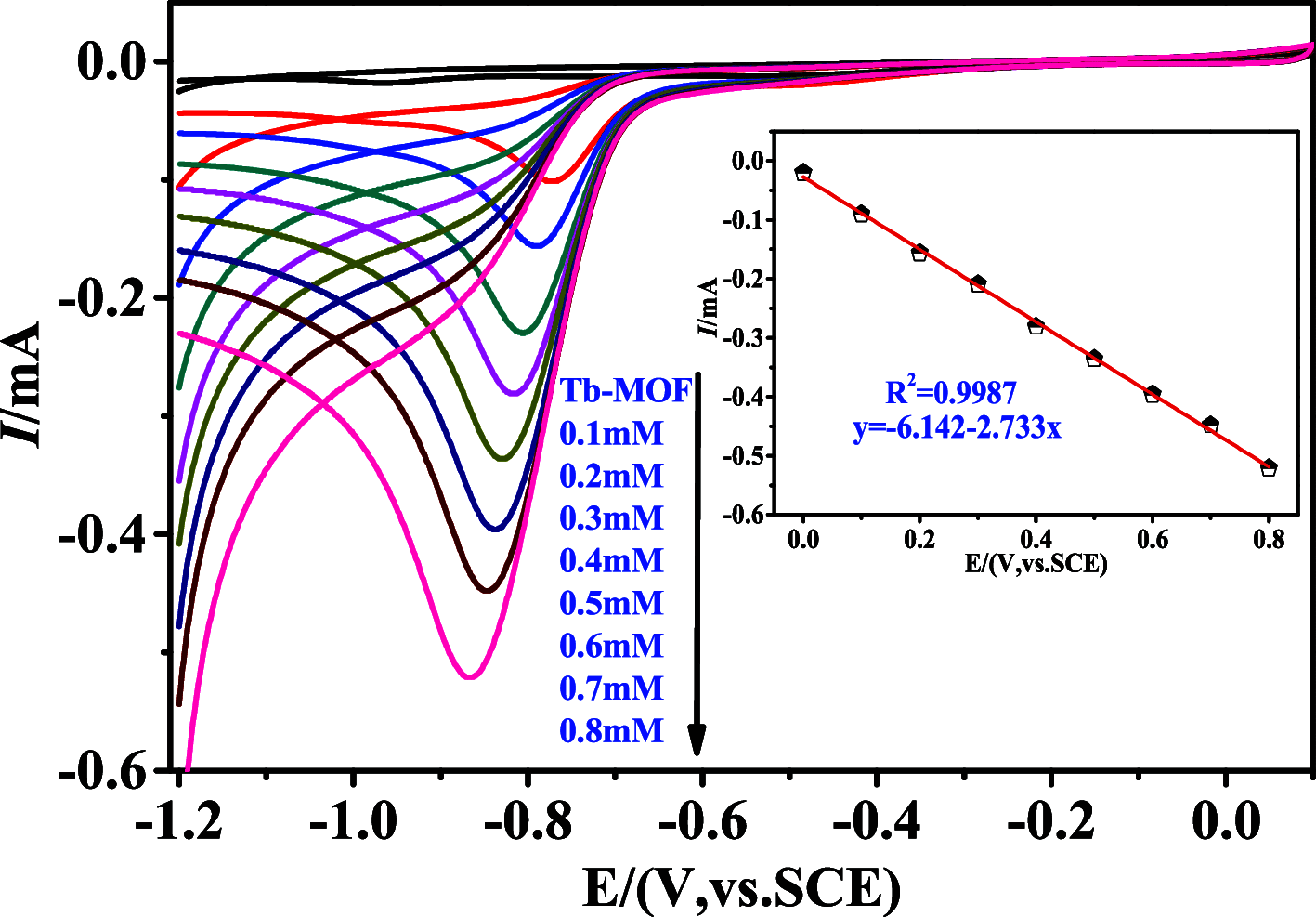A Multifunctional Tb-MOF Detector for H2O2, Fe3+, Cr2O7 2-, and TPA Explosive Featuring Coexistence of Binuclear and Tetranuclear Clusters
- PMID: 33403265
- PMCID: PMC7774076
- DOI: 10.1021/acsomega.0c04526
A Multifunctional Tb-MOF Detector for H2O2, Fe3+, Cr2O7 2-, and TPA Explosive Featuring Coexistence of Binuclear and Tetranuclear Clusters
Abstract
A novel three-dimensional microporous terbium(III) metal-organic framework (Tb-MOF) named as [Tb10 (DBA)6(OH)4(H2O)5]·(H3O)4 (1), was successfully obtained by a solvothermal method based on terbium nitrate and 5-di(2',4'-dicarboxylphenyl) benzoic acid (H5DBA). The Tb-MOF has been characterized by single crystal X-ray diffraction, elemental analysis, thermogravimetry, and fluorescence properties, and the purity was further confirmed by powder X-ray diffraction (PXRD) analysis. Structural analysis shows that there are two kinds of metal cluster species: binuclear and tetranuclear, which are linked by H5DBA ligands in two μ7 high coordination fashions into a three-dimensional microporous framework. Fluorescence studies show that the Tb-MOF can detect H2O2, Fe3+, and Cr2O7 2- with high sensitivity and selectivity and can also be used for electrochemical detection of exposed 2,4,6-trinitrophenylamine (TPA) in water. The highly selective and sensitive detection ability of the Tb-MOF might make it a potential multifunctional sensor in the future.
© 2020 American Chemical Society.
Conflict of interest statement
The authors declare no competing financial interest.
Figures










Similar articles
-
Novel Multifunctional Samarium-Organic Framework for Fluorescence Sensing of Ag+, MnO4 -, and Cimetidine and Electrochemical Sensing of o-Nitrophenol in Aqueous Solutions.ACS Omega. 2021 Mar 3;6(10):6810-6816. doi: 10.1021/acsomega.0c05867. eCollection 2021 Mar 16. ACS Omega. 2021. PMID: 33748594 Free PMC article.
-
Five Mesoporous Lanthanide Metal-Organic Frameworks: Syntheses, Structures, and Fluorescence Sensing of Fe3+, Cr2O72-, and H2O2 and Electrochemical Sensing of Trinitrophenol.Inorg Chem. 2022 May 16;61(19):7286-7295. doi: 10.1021/acs.inorgchem.1c03935. Epub 2022 May 2. Inorg Chem. 2022. PMID: 35500301
-
A novel microporous Tb-MOF fluorescent sensor for highly selective and sensitive detection of picric acid.RSC Adv. 2018 Jun 13;8(39):21671-21678. doi: 10.1039/c8ra02602e. eCollection 2018 Jun 13. RSC Adv. 2018. PMID: 35541725 Free PMC article.
-
A multi-responsive luminescent sensor based on a super-stable sandwich-type terbium(iii)-organic framework.Dalton Trans. 2016 Oct 4;45(39):15492-15499. doi: 10.1039/c6dt03057b. Dalton Trans. 2016. PMID: 27711861
-
Preparation of Eu0.075Tb0.925-Metal Organic Framework as a Fluorescent Probe and Application in the Detection of Fe3+ and Cr2O72.Sensors (Basel). 2021 Nov 5;21(21):7355. doi: 10.3390/s21217355. Sensors (Basel). 2021. PMID: 34770661 Free PMC article.
Cited by
-
A novel 3D terbium metal-organic framework as a heterogeneous Lewis acid catalyst for the cyanosilylation of aldehyde.RSC Adv. 2021 Oct 27;11(55):34779-34787. doi: 10.1039/d1ra06533e. eCollection 2021 Oct 25. RSC Adv. 2021. PMID: 35494756 Free PMC article.
-
A luminescent probe based on terbium-based metal-organic frameworks for organophosphorus pesticides detection.Mikrochim Acta. 2022 Nov 2;189(11):438. doi: 10.1007/s00604-022-05508-x. Mikrochim Acta. 2022. PMID: 36319758
-
Synthesis of a Cd-MOF Fluorescence Sensor and Its Detection of Fe3+, Fluazinam, TNP, and Sulfasalazine Enteric-Coated Tablets in Aqueous Solution.ACS Omega. 2023 Jun 28;8(27):24635-24643. doi: 10.1021/acsomega.3c03073. eCollection 2023 Jul 11. ACS Omega. 2023. PMID: 37457463 Free PMC article.
References
-
- Zhao J.; Dong W.-W.; Wu Y.-P.; Wang Y.-N.; Wang C.; Li D.-S.; Zhang Q.-C. Two (3,6)-connected porous metal–organic frameworks based on linear trinuclear [Co3(COO)6 ] and paddlewheel dinuclear [Cu2(COO)4 ] SBUs: gas adsorption, photocatalytic behaviour, and magnetic properties. J. Mater. Chem. A 2015, 3, 6962–6969. 10.1039/C4TA06537A. - DOI
LinkOut - more resources
Full Text Sources
Research Materials

